The wonders of ancient Mesopotamia
review by Antonio Sagona
The accomplishments of the ancient Near East, a region roughly comparable to the modern geopolitical Middle East, do not resonate as loudly in the psyche and thought of contemporary society as do, say, the achievements of Greece and Rome, or even Egypt. There are any number of reasons for this ‘Cinderella syndrome’. Many would acknowledge, for instance, a privileged role for Greek civilisation in generating certain foundational values such as democracy, rational thought, and the aesthetics of Western visual arts. Others would point to the remarkable feats of Roman technology manifested in their extraordinary structures — arches and aqueducts, monumental buildings and roads — structurally complicated forms that were made possible by their innovative development of concrete. Somehow we can easily engage with both of these classical civilisations because we can identify the origins of much of our Western lifestyle. And then there is Egypt, remoter in time, to be sure, but whose standing remains and riches are awe-inspiring. Add to that the ubiquitous mummy that has captured the popular imagination at least since Edgar Allan Poe’s short story, ‘Some words with a mummy’, or femme fatale figures, such as Nefertiti and Cleopatra, which have helped fuel the cinema industry, and you have a few of the ingredients that have contributed to modern ‘Egyptomania’.
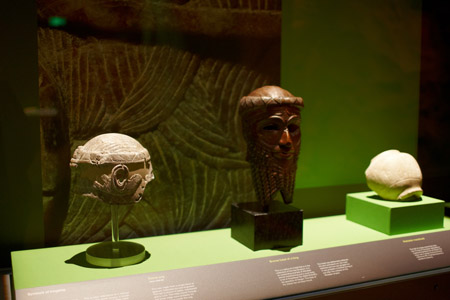
The ancient Near East, with Mesopotamia as its heartland, is seemingly less eye-catching and more distant than all of this, even though the ancient names of some of its cities still reverberate around our contemporary world: Ur of the Chaldees, Babylon, and Nineveh. For a start, its civilisations — and there were many — built mud-brick architecture, which quickly eroded after abandonment, and soon disappeared from sight, awaiting the trowel and spade of the archaeologist. And when their remains are brought to light, they seem to require a more guided interpretation to make sense of them. Even so, we should be aware of our indebtedness to the central place Mesopotamia occupies in world history, not least because many of its achievements are germane to issues and themes that remain current and active in today’s world. This comparison between Mesopotamia and other ancient civilisations is inevitable given the preceding Masterpieces exhibitions at Melbourne Museum, A Day in Pompeii and The Treasures of Tutankhamun.
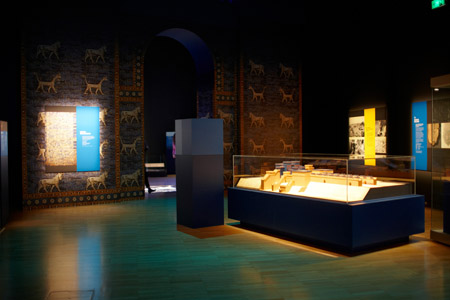
Museum Victoria
So, then, does this exhibition do justice to the diversity and high level of cultural attainment ascribed to this ‘cradle of civilisation’? The answer is a resounding ‘Yes’. At the entrance to this superb exhibition, made possible through a collaboration between the Melbourne Museum and the British Museum, a panel with 26 words, in varying font sizes for emphasis, alludes to the major legacies of Mesopotamia: writing, cities, time, kingship, long-distance trade, administration, and so on. Each of these themes is clearly and crisply explained throughout the exhibition at the specific points. Juxtaposed to the entrance panel is a well-designed, multimedia timeline, ranging from 3500 BC to the present day. The astute viewer would realise that less time has elapsed between the demise of ancient Mesopotamia (about 330 BC) and our society, than between Mesopotamia’s take off in the mid-fourth millennium BC and its end. During these three extraordinary millennia, Mesopotamia set the agenda for the development of later civilisations, Greece and Rome included.
A chronological display works well for Mesopotamia. The exhibition is divided into four broad component parts spread across several galleries: Early Mesopotamia (Sumer and the early empires), Assyria, Babylon and Late Mesopotamia (the Neo-Babylonian period). Each part provides thoughtfully chosen snapshots. From the outset, we are reminded of Mesopotamia’s geographical situation, the alluvial land between the two rivers Euphrates and Tigris, comprising two regions: a northern area which was defined, in part, by the Taurus and Zagros mountains, and a southern expanse that terminated in marshes and canals, the mythical homeland of the Sumerian god Enki, lord of the Abzu, the primordial freshwater sea located beneath the earth. Another panel, an aerial photograph of the large, flat-topped earthen mound in the centre of modern Erbil, in Iraqi Kurdistan, vividly illustrates what ancient cities look like before they are excavated — an accumulation of mud-brick debris many metres high that punctuate the modern landscape.
Quite appropriately, the first artefacts in this exhibition are Sumerian clay tablets, representing the earliest writing system anywhere in the world. Writing is surely nothing less than one of the greatest, if not the greatest legacy of the ancient world. It is hard to imagine a world without writing. The ability to record language, thoughts and ideas using a flexible communicative system is fundamental to our daily existence, and it originated in Mesopotamia. While inquisitive visitors may understand the general principle of how pictographs were gradually transformed into the cuneiform script, they may well puzzle over the conditions of the invention of writing which involves the even earlier use of symbols and mnemonic devices. Or how a series of pictographs gradually developed into meaningful sentences, reflecting grammatical and syntactical rules.
Next come items that are quintessentially Mesopotamian — cylinder seals. These small, perforated cylinders of stone or clay were richly engraved with a design, often a story, which left a continuous relief impression when the cylinder was rolled onto wet clay. Large photographs accompany these artefacts and leave no doubt as to the high level of glyptic art achieved by Mesopotamian artisans. These seals served two purposes. First, they represented authority or ownership, and were developed in tandem with writing, with tablets sometimes bearing their impressions. Second, and less well explained in the panels, is that they were a symbolic form of allegiance. Possibly worn on a string or threaded through a pin, these small items pledged loyalty to whichever deity or king was represented on the intaglio.
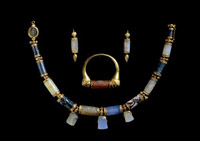
The Trustees of the British Museum
The central display of the early Mesopotamian section comprises items from the Royal Graves at Ur. Sumptuous artefacts made from precious metals and lapis lazuli, the latter imported from Afghanistan, provide a taste of this spectacular and unique site. In so many ways, these royal graves remain an enigma. They represent power and prestige on a grand scale, yet the names inscribed on some of the objects are not those of known Sumerian royalty. Who were these elites? They wielded enough power to commit a retinue of attendants to the afterlife, yet they remain an enigma.
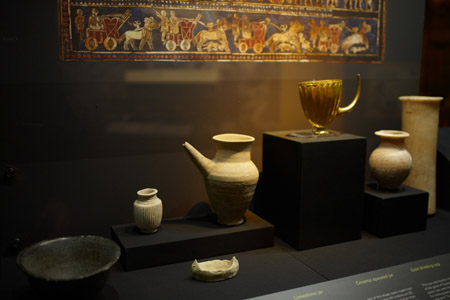
Museum Victoria
A pair of colossal human-headed bulls, the lamassu, guards the entrance to the Assyrian gallery, a step into another millennium. They are splendid replicas of the limestone, hybrid creatures that protected Assyrian palaces from evil spirits. Once inside the gallery, the visitor is immediately struck by a number of large slabs of stone carved in low relief that once lined the lavish palaces of the later (Neo-Assyrian) kings. This is ‘narrative art’ at its best — they relate a story, depicting action surrounding an event. In every case, the focus is on the king. Close examination will reveal that human figures had their clothes, hairstyles and musculature represented in fine detail, and the acute lighting of the display highlights these features extremely well. These stone reliefs may seem cold and static, despite the fact that they were originally painted in vivid colours. To engage the visitor, some of the reliefs are juxtaposed to a computer-generated narrative, which interprets the snapshot on the reliefs. These animated cartoons are truly excellent.
Writing is again a feature, this time in the form of the more developed tablets found in the library of Nineveh. Several thousand tablets were discovered, among them the most complete and latest version of the Epic of Gilgamesh. The story of this Mesopotamian hero deserves a place in the world’s greatest literature, not only because the original Sumerian version antedates Homeric epic by at least one and a half thousand years, but also because of the quality and character of the story that it tells — a mixture of pure adventure, of morality, and of tragedy. At this point in the exhibition, the visitor may well be boggled not only by the accomplishments of the Mesopotamians, but by the region’s antiquity and longevity. It is sobering to think that Assyria, with its cities populated by thousands, flourished between the ninth and seventh centuries BC, when Rome was little more than a village of wattle-and-daub structures. The last part focuses on Babylon. A replica of Hammurabi’s Law Code, now in the Louvre, and a reconstruction of the entrance of Ishtar’s gate at Babylon, richly decorated with vivid glazed and ornamented bricks, together with a thoughtfully selected range of objects, reinforce the sophistication that was Mesopotamia.
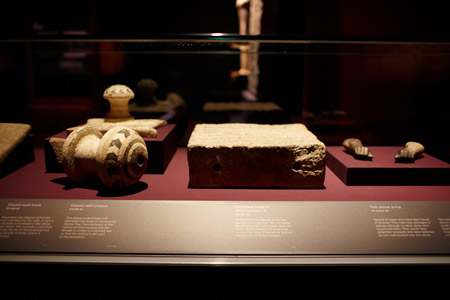
Museum Victoria
Throughout the exhibition there are photographs of the archaeologists and personalities who excavated these wonders of Mesopotamia —Leonard Woolley (an exacting taskmaster) and Katherine Woolley, Max Mallowan and his wife, Agatha Christie, to mention a few. The emphasis is on the rediscovery of the Near East in the eighteenth century and on the early decades of the twentieth century when archaeology ‘came of age’ and excavations looked like a movie set for a Cecil B DeMille film, rather than the slow, forensic analysis of today’s fieldwork.
I left the exhibition satisfied that it presented the essence of ancient Mesopotamia. At the exit, you are reminded of the legacies of Mesopotamia with a repeat of the panel positioned at the entrance. Although much is made in this exhibition of the connections with modern society, we should also realise that these ancient communities understood things in very specific ways that are quite distinct from our own modes of ‘seeing’. This has consequences for the production of art, the practice of religion, and the individual’s perception of the world and the self.
Antonio Sagona is professor of archaeology in the School of Historical and Philosophical Studies at the University of Melbourne.
| Exhibition: | The Wonders of Ancient Mesopotamia |
| Institution: | The British Museum and the Melbourne Museum |
| Curator: | Sarah Collins, The British Museum |
| Exhibition design: | Lilford Smith Design |
| Graphic design: | Blue Vapours |
| Floor space: | 950 square metres |
| Venue/dates: |
Melbourne Museum, 4 May 2012 – 7 October 2012 |
| Catalogue: | Sarah Collins, The Wonders of Ancient Mesopotamia, Museum Victoria, Carlton, 2012, ISBN 9781921833144 (pbk), RRP $20 |
| Website: | http://museumvictoria.com.au/melbournemuseum/whatson/current-exhibitions/the-wonders-of-ancient-mesopotamia/ |
